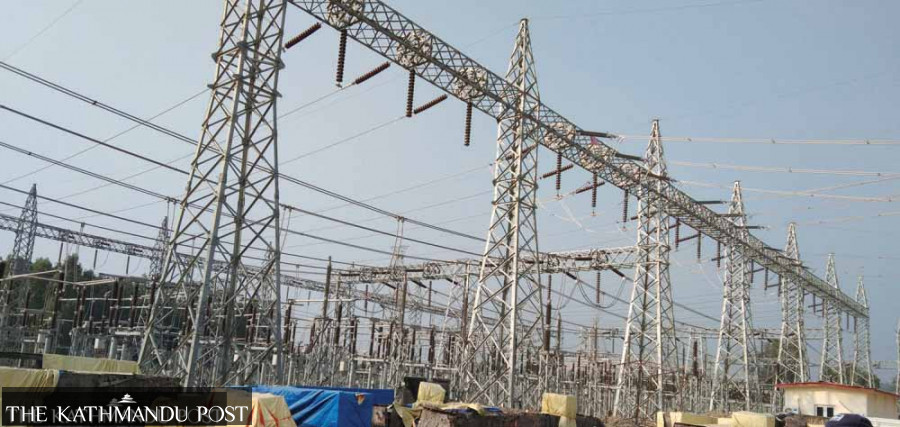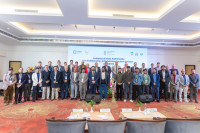National
High prices of imported electricity could affect power utility’s finances
Nepal has been importing around 1,000MW of electricity from India a day as peak hour demand is around 1,600MW.
Prithvi Man Shrestha
Nepal’s peak demand for power is in the evening. Since the country does not have enough, it has to import electricity from India. The Nepal Electricity Authority, however, has been importing most power from the southern neighbour in the daytime because buying electricity from India during the evening is expensive.
As the water level in Nepal's rivers has started to decrease causing a massive decrease in power production in the country, Nepal has been importing power, around 1,000MW, from India to compensate for the deficit.
In winter, Nepal imports electricity from India as power plants operate at as low as 30 to 40 percent of their capacity. In mid-January, Nepal’s total power generation capacity including that of hydropower projects, solar and thermal plants stood at 2,055.74MW, according to Nepal Electricity Authority (NEA).
According to the NEA, the country’s peak hour demand for electricity stands at 1600MW but domestic production amounts to around 650MW only.
But despite high demand for electricity in the evening, the NEA has been importing most of its power from India during the day and in the time when prices are lower. “It is because buying electricity during peak hours in the evening from India’s power exchange market is much expensive,” said Suresh Bhattarai, spokesperson at the NEA.
At one point of time in the afternoon on Monday, the NEA was importing around 400 MW of electricity, 195 MW from each of the two lines, through the Dhalkebar-Muzaffarpur 400kV transmission line, according to the data maintained by the Nepal’s Grid Operation Department at Dhalkebar.
“We try to skip buying power in the peak hours [evening time] as much as possible because of high prices of electricity during the peak hours in the Indian power exchange market,” Bhattarai said.
For example, the NEA was taking delivery of just 23MW from one circuit while 28MW from another circuit of the Dhalkebar-Muzaffarpur Cross-Border Transmission Line at 7pm on Sunday, according to the records at the Dhalkebar Grid Office.
“But it is not always possible to skip the peak hours to buy electricity because our system should also operate,” said Bhattarai, who also directs the system operation department.
According to Bhattarai, the NEA has paid as much as INR 20 or Rs32 per unit to buy electricity from India. “By adding taxes, we have to pay as much as Rs35 per unit,” he said.
According to Lokendra Saud, assistant director at the finance department of the NEA, the authority had paid a maximum of INR 6.68 per unit for the import of electricity from India in February. The country imported electricity worth over Rs2 billion from India in February, according to him.
On Tuesday, the maximum market clearing price per unit at the Indian Energy Exchange (IEX) Market stood at INR 16, according to the IEX website.
Average market clearing price per unit stood at INR 7.16.
Nepal has been importing electricity from India’s power exchange market since the southern neighbour opened the exchange market for Nepal in April last year.
According to an Indian media report, electricity prices in the spot electricity market rose 31 percent in February 2022 and the prices continue to remain firm. With the fuel prices over the roof due to the Ukraine crisis, the fuel and coal-based power plants have become expensive in India.
With the cost of producing electricity increasing in India, given the rise in operating costs of coal and diesel plants, the southern neighbour has stopped providing electricity at the fixed rate from Tanakpur since mid-February.
“We have not received electricity from Tanakpur point since February 13,” said Bhattarai.
Nepal can receive up to 85MW through Tanakpur point at the rate of INR 4.12 (Rs6.62) per unit, according to Prawal Adhikari, director of the NEA’s power trade department.
PTC India Limited is responsible for supplying electricity through this route. With the PTC India not supplying electricity for a month, the NEA has been forced to purchase the electricity from the energy exchange market where the prices have become expensive now.
“Until late February, we were receiving electricity for INR 2.99 per unit and INR 3.90 per unit,” said Bhattarai. “Now, the prices have gone over the roof.”
The NEA has been buying electricity from independent power producers at Rs8.4 per unit in the dry season. NEA officials are concerned about how long the Ukraine crisis prolongs and how long the electricity prices in India remain high as the power utility has been forced to buy electricity at higher prices and sell it at lower rates.
“Input costs for diesel and coal-based power plants in India increased due to the Ukraine war. So overall prices of electricity in India have soared in recent days,” said Adhikari, director of the authority’s power trade department.
Consumer prices of electricity sold by the NEA vary depending upon consumers. As per the new tariff implemented by the Electricity Regulatory Commission since October, households who use 150 units to 250 units per month have to pay Rs9.50 per unit. And households using up to 400 units per month in the dry season have to pay Rs11.50 per unit.
“If the NEA has to pay more continuously for buying electricity than the price it receives for selling the electricity, NEA’s financial health will worsen,” said Bhattarai. During the first half of the current fiscal year, the NEA’s unaudited profit was Rs12.12 billion, according to its statistics. This came years after the power utility’s mounting debt—Rs27 billion—was written off by the government.
Amid such a scenario, the NEA has sought to avoid buying peak-hour electricity. It has been buying more electricity from India in the daytime while reserving water for the peak hour production such as at the 456MW Upper Tamakoshi and 144MW Kaligandaki Hydropower projects. That helps alleviate the peak hour demand.
Officials at the NEA, however, say the Kulekhani storage projects (106MW) and peaking power plants alone could not sustain the power demands of the country for prolonged periods in the peak hours without importing high-priced electricity from India. Currently, the country has only one reservoir type project—Kulekhani. Tanahun Hydropower (140MW), a reservoir type project, is under construction.
“We need at least one large reservoir type hydropower project in operation such as the 1,200MW Budhigandaki Hydropower Project to avoid any risk of power shortages in the dry season,” said Bhattarai.




 20.12°C Kathmandu
20.12°C Kathmandu















